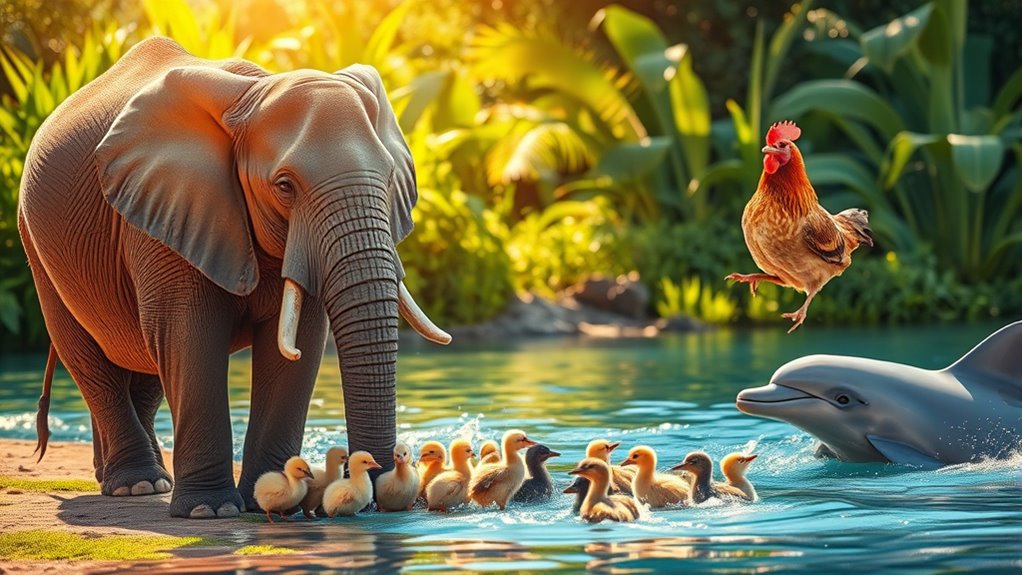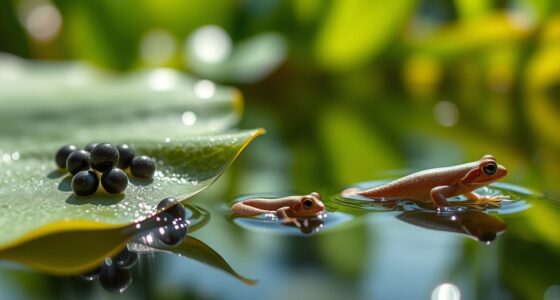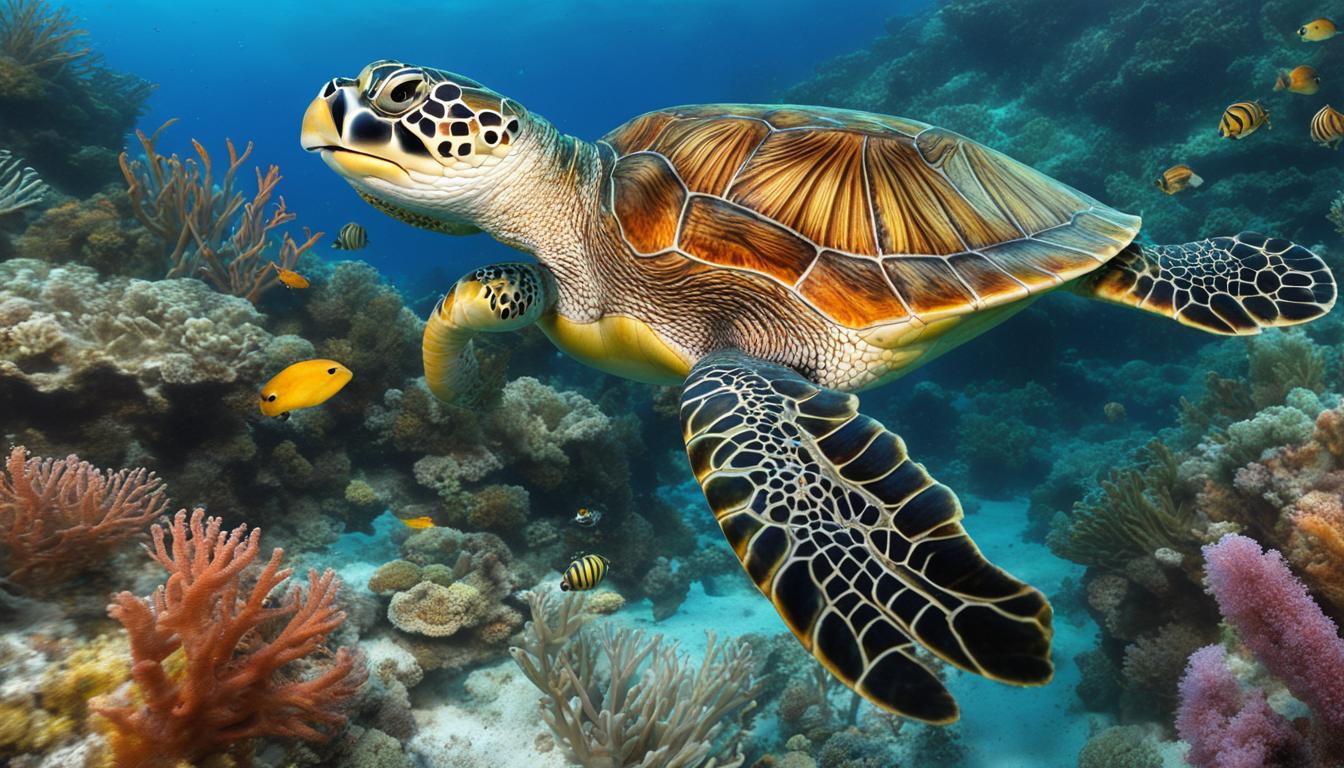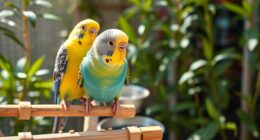Animals showcase diverse parenting styles to guarantee their young thrive. Maternal care in leopards and nurturing from biparental golden jackals highlight strong family bonds. Unique examples, like male gharials providing rides for hatchlings and brood parasites tricking other species, further illustrate the complexity of animal parenting. Emotional influences shape behaviors, too, with some parents overprotecting while others encourage independence. If you explore deeper, you'll discover even more fascinating insights about these animal families.
Key Takeaways
- Mother leopards and sloth bear mothers form strong emotional bonds, teaching survival skills and nurturing their young for extended periods.
- Male gharials actively participate in parenting by guarding nests and giving rides to hatchlings, showcasing protective behaviors.
- Jacanas uniquely involve males in sole parenting, while golden jackals and striped hyenas benefit from biparental care that enhances offspring survival.
- Alloparental care, as seen in elephants and flamingos, involves non-parents aiding in child-rearing, improving social skills and survival rates.
- Diverse parenting styles in the animal kingdom range from overprotective kangaroos to balanced dolphin parents, emphasizing the importance of emotional support and independence.
Maternal Care

When you observe the animal kingdom, it's fascinating to see how deeply maternal care influences survival. For instance, mother leopards dedicate the first two years of their cubs' lives to protection and teaching essential survival skills.
Similarly, sloth bear mothers carry their young for up to two years, imparting critical knowledge on how to thrive in their environment. You'll notice strong emotional bonds between these mothers and their offspring, emphasizing the depth of maternal connections.
Sloth bear mothers nurture their young for two years, forming deep emotional bonds and teaching vital survival skills.
Successful reunions of mother leopards with lost cubs showcase their powerful instincts and attachment. However, threats like poaching and habitat loss challenge sloth bear mothers, impacting their ability to provide the nurturing care their cubs desperately need.
This highlights the varying parenting styles across species.
Paternal and Biparental Care

When you think about animal parenting, you might be surprised by the active roles some fathers take.
For instance, male gharials give their young rides on their backs, while jacanas take full responsibility for their offspring.
Understanding these unique dynamics can shed light on the benefits of biparental care in species like golden jackals and striped hyenas.
Male Gharials' Active Parenting
Male gharials exhibit remarkable parenting skills, standing out among reptiles for their active involvement in nurturing their young.
These dedicated fathers often give rides to their hatchlings on their backs, enhancing their mobility and safety in the water. This unique form of parenting allows the young gharials to learn how to navigate their aquatic environment while staying close to their father for protection.
Unlike many other species where males play little to no role, male gharials guard their nests to keep predators at bay as their young emerge.
The collaboration between male and female gharials in childcare reflects a rare biparental care approach, greatly boosting the survival rates of their offspring. This teamwork underscores the importance of both parents in the nurturing process.
Jacanas' Sole Responsibility
In the world of jacanas, it's the males who take on the full responsibility of raising their young, a striking contrast to many bird species where both parents share duties. This unique parenting style is fascinating, as females mate with multiple males, leaving the males to care for the chicks alone. These attentive fathers protect and guide their young, ensuring they learn to forage and navigate their environment safely.
| Aspect | Male Jacanas' Role | Importance |
|---|---|---|
| Caregiving | Sole responsibility | Essential for survival |
| Protection | Guard against predators | Increases chick survival |
| Teaching | Foraging skills | Prepares for independence |
| Nurturing | Constant attention | Builds strong bonds |
| Mating Strategy | Female polyandry | Supports genetic diversity |
Biparental Care Benefits
Though parenting styles vary widely across the animal kingdom, biparental care offers distinct advantages that enhance offspring survival.
In species like emperor penguins, the male incubates eggs while the female forages, ensuring the young thrive even in harsh conditions. Male gharials provide rides on their backs, promoting safety and mobility for their young in the water.
Similarly, barn owl fathers supply food to chicks, allowing mothers to focus on incubation. In golden jackals and striped hyenas, both parents contribute to raising their young, which boosts survival rates.
This division of labor not only maximizes reproductive success but also creates a supportive environment where offspring can grow healthier and stronger, emphasizing the importance of biparental care in the animal world.
Brood Parasites

Brood parasites, like the Asian koel, have some clever tactics up their sleeves.
They lay eggs that mimic those of their host, tricking unsuspecting parents into raising their young.
But this manipulation can come with serious consequences for the host families, as they may face harm when caring for these alien chicks.
Egg Mimicry Tactics
While many birds diligently nurture their young, certain species have devised cunning strategies to bypass the demands of parenting altogether. One fascinating method is egg mimicry, employed by brood parasites like the Asian koel.
By laying eggs that closely resemble those of their host species, these clever birds deceive unsuspecting parents into raising their chicks alongside their own. This tactic not only saves the koel from the burdens of rearing its young but also increases its reproductive success.
However, brood parasites aren't always gentle; species like the European spotted cuckoo may aggressively intervene if hosts refuse to care for their chicks, sometimes causing harm to the host's eggs or young. Such risks highlight the complex dynamics of brood parasitism in nature.
Host Manipulation Strategies
Many species of brood parasites have evolved intricate host manipulation strategies that guarantee their offspring thrive at the expense of others.
For instance, the Asian koel lays its eggs in the nests of other birds, using egg mimicry to trick host parents into raising its young. This clever strategy increases the chances of survival for the koel chicks while the unsuspecting host parents remain none the wiser.
Other brood parasites, like the European spotted cuckoo, take a more aggressive approach, sometimes pushing host eggs out of nests to assure their own offspring are prioritized.
Consequences for Host Families
The presence of brood parasites can have devastating consequences for host families, often leading to a dramatic shift in their reproductive success.
Brood parasites, like the Asian koel and European spotted cuckoo, lay their eggs in the nests of unsuspecting host parents. These parasites cleverly mimic the color and pattern of the host's eggs, tricking the host into incubating and raising their young.
When host parents refuse to care for these intruders, they sometimes face aggressive retaliation, resulting in harm or eviction of their own chicks. Instances of nest damage highlight the risks host families encounter.
Ultimately, brood parasitism allows parasites to escape parental responsibilities, drastically affecting the survival and reproductive outcomes of their host species.
Alloparental Care

Alloparental care showcases the remarkable ways animals nurture their young beyond direct parental involvement. In various species, non-direct descendants provide essential support, fostering strong social bonds. For example, elephants have allomothers—older females who assist in raising calves, boosting their survival rates. Similarly, flamingos in same-sex partnerships share parenting duties, highlighting flexible familial roles.
| Animal | Type of Alloparental Care |
|---|---|
| Rhesus macaques | Joint family structures |
| Elephants | Allomothering behaviors |
| Flamingos | Same-sex partnerships |
| Monkeys | Orphan rehabilitation |
Wildlife SOS emphasizes the importance of alloparental care for developing social skills, showing how these community ties can help mitigate emotional pain during separations.
Emotional Animals

Animals experience a wide range of emotions, influencing how they parent their young.
Take jellyfish parents, for instance; they often struggle with distress and anxiety, which can create family tension. In contrast, ostrich parents are emotional avoiders, concealing their feelings and dismissing their child's anxieties as mere phases, focusing instead on practical support.
Kangaroo parents aim to protect their children from distress, but sometimes their overprotection can hinder their child's coping skills. Meanwhile, rhinoceros parents adopt a logical approach, which may appear dismissive and limit the child's ability to work through issues independently.
Terrier parents, as emotional animals, tend to micromanage, overwhelming their children with support, leading to feelings of burden.
Each primary caregiver's emotional style shapes their child's emotional development.
Behavioral Animals

While many creatures display unique parenting behaviors, the methods they employ can markedly impact their offspring's development.
For instance, kangaroo parents are protective but may hinder their children's coping skills by being overly delicate. Rhinoceros parents take a logical approach, encouraging problem-solving, yet risk coming off as dismissive if their children aren't allowed to work through challenges independently.
On the other hand, terrier parents showcase dedication but often micromanage, which can overwhelm their kids. Dolphin parents strike a balance, guiding their children while allowing for exploration in a nurturing environment.
These varied parenting styles in the animal kingdom offer valuable parenting tips, emphasizing the importance of balance to foster healthy emotional and developmental growth in offspring.
Frequently Asked Questions
What Are the 4 Types of Parental Care in Animals?
When you look at parental care in animals, you'll find four main types.
First, there's maternal care, where mothers protect and nurture their young.
Then, you have paternal or biparental care, with both parents involved in raising offspring.
Brood parasitism is where some species lay eggs in others' nests, tricking them into raising their chicks.
Finally, alloparental care involves individuals other than biological parents helping to raise the young, strengthening social bonds.
What Are the 4 Types of Parenting Styles?
Imagine you're maneuvering parenting like a tightrope walker.
You've got four styles to evaluate: Authoritarian, where you enforce strict rules and high expectations; Authoritative, which balances structure with warmth; Permissive, where you encourage freedom and play; and Uninvolved, where you're barely engaged.
Each style impacts your child's development differently. Reflecting on your approach can help you adapt and foster a nurturing environment that suits both you and your child's needs.
What Animal Is the Most Protective Mother?
When you think about the most protective mother in the animal kingdom, leopards often come to mind. They fiercely guard their cubs for the first two years, ensuring their safety.
However, you might also consider sloth bears, who carry their young for up to two years, teaching them essential skills.
Female alligators and orangutans also demonstrate incredible protectiveness, creating strong bonds and defending their young against threats.
Each showcases unique nurturing instincts.
What Is Tiger Parenting Style?
Imagine a fierce tiger prowling the jungle, fiercely protective of its cubs. That's the essence of tiger parenting.
This style pushes you to enforce strict discipline and high expectations on your children, prioritizing achievement over emotional connection. You might impose rigid rules, limiting social interactions and focusing on rigorous academics and activities.
While you believe this prepares them for a competitive world, it can sometimes stifle creativity and lead to anxiety.
Conclusion
In the animal kingdom, parenting styles vary widely, showcasing the incredible diversity of life. From devoted maternal care to the cunning tactics of brood parasites, each approach highlights the unique strategies animals employ to guarantee their offspring's survival. As the saying goes, "It takes a village to raise a child," and you can see that in the alloparental care seen in many species. Ultimately, nature's tapestry of parenting reminds us that love and nurture come in many forms.










